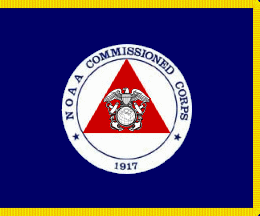
 |
National Oceanic & Atmospheric Administration |
On this page:
The Coast and Geodetic Survey was authorized a distinguishing flag, blue with a red triangle on a white disk, on January 16, 1899. The design was emblematic of the triangulation method used in surveying. The current NOAA service flag, normally displayed at the masthead of the forwardmost mast as a distinctive mark of a NOAA vessel in commission, was adapted from the Coast and Geodetic Survey flag by adding the NOAA emblem, a two-tone blue circle with the silhouette of a seabird in white, on the center. On single-masted vessels, the service flag flies immediately beneath the commission pennant or personal flag of a civilian official or flag officer. NOAA vessels display the national ensign and union jack in the same manner as those of the Navy and Coast Guard, and follow the movements of the senior Navy or Coast Guard vessel if present together in the same port.
 This flag was adopted in 2002 to represent NOAA's commissioned officer corps as a uniformed service, as opposed to NOAA itself as an
agency that includes both commissioned and civilian personnel. Like the similar flags of the other uniformed services, it is used for ceremonial purposes and indoor display, not flown
from a fixed pole or aboard ship.
This flag was adopted in 2002 to represent NOAA's commissioned officer corps as a uniformed service, as opposed to NOAA itself as an
agency that includes both commissioned and civilian personnel. Like the similar flags of the other uniformed services, it is used for ceremonial purposes and indoor display, not flown
from a fixed pole or aboard ship.
The Deputy Administrator's
position equates to that of an Assistant Secretary of Commerce, also equivalent to four-star rank. The Deputy's flag is the same as the Administrator's
but with the stars in red instead of white, and like the Administrator's is mounted on a staff with a halberd finial.
The chief scientist
of NOAA flies a flag similar to that of the Deputy Administrator, but with
three stars in a vertical line in the hoist. Depending on the chief scientist's
paygrade within the Senior Executive Service, the flagstaff is topped
with either a halberd or a ball.
The Commissioned Corps of the National Oceanic and Atmospheric Administration, consisting of some 250 officers, is the smallest of the United States' seven uniformed services. Its grade structure normally goes up only to (two-star) rear admiral, but provision is made in the NOAA flag directive (NOAA Adminisrative Order 201-6) for a three-star vice admiral's flag, used on those occasions when a uniformed officer is appointed to a more senior administrative position in the organization and promoted on that basis to three-star rank. The flags shown below are in the proportions used aboard ship and on fixed flagpoles. They also exist in the standard ceremonial size of 52 by 66 inches, in which case they are trimmed with golden yellow fringe, cords, and tassels. The flagstaff ornament for all NOAA Corps flag officers is a halberd.
As of 2015, NOAA has one vice admiral, who serves as
Deputy Under Secretary for Operations.
The Director
of the NOAA Commissioned Corps, double-hatted as Director of Marine and Aviation Operations, is the service's only two-star admiral.
The flag, a triangle flanked by two white stars, is the same as that used by the director of the former Coast and Geodetic Survey before its merger into NOAA.
This is the most recent in a series
of one-star flags that were first created in 1982 when Congress established
the position of commodore admiral in the Navy, Coast Guard, and NOAA Corps.
The flag shown reflects the final resolution in 1985 to restore the traditional
rank of rear admiral (lower half) but with a one-star rather than two-star
rank insignia and flag. There are currently two officers of this rank in the NOAA Corps.